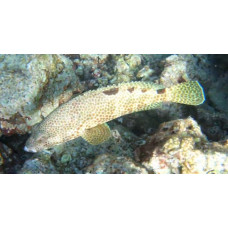Latin name
Epinephelus merra
Other name
Black-spotted rock-cod, common birdwire rockcod, dwarf spotted rockcod, dwarf-spotted grouper, honeycomb cod, wire-netted reefcod or wire-netting cod.
Identification
The honeycomb grouper has a stocky body with an oval profile. The interorbital region is flat and the head profile is convex. The eyes are globular. The lower jaw is longer than the upper jaw and there are 2-4 rows of teeth in the mediolateral part of the lower jaw.
Features of fish fins
This species has a long dorsal fin with eleven spines, 15-17 dorsal soft rays and 8 anal soft rays. The caudal fin is rounded.
Fish colouring
The body of the honeycomb grouper is ochre to light brown. It is covered with small brown hexagons with light intervals, arranged on darker irregularly shaped diagonal stripes forming a network (hence the common name of the species). These hexagonal spots are also present on all fins. The eyes with pupils are reddish brown to black in colour.
Distribution
One of the most common small seabasses in the Indo-Pacific. It is widespread in the tropical waters of the Indo-Pacific from South Africa to Pitcairn, north to southern Japan, south to Lord Howe Island. It is not found in the Red Sea, Persian Gulf, coastal areas of India and Hawaii.
Habitat
They live on coastal reefs and in shallow lagoons, usually at depths of less than 20 m, but can reach 50 m. Juveniles prefer reefs with staghorn corals (Acropora species).
Size
The honeycomb grouper reaches a maximum known length of 32 centimetres (13 inches) and is one of the smallest fish species in the genus Epinephelus.
Behavior
These lone sea bass.
Food and feeding habits
They feed mainly on fish, crabs, shrimps and cephalopods, and their numbers increase with age.
Reproduction
When they reach sexual maturity, they are first females and then turn into males. Sea bass of 16 cm in length are usually still females. These fish usually spawn from January to April, starting 2-3 days before the full moon and lasting about 3-4 days.
Fishing
This species is not commercially important.
Relationship with a person
A species of fish harmless to humans.
| Classification | |
| Phylum | Chordata |
| Class | Actinopterygii |
| Squad | Perciformes |
| Family | Serranidae |
| Genus | Epinephelus |
| Species | E. merra |
| Features | |
| Conservation status | Least Concern |
| Habitat | Pelagic |
| Life span, years | No information |
| Maximum body weight, kg | No information |
| Maximum length, cm | 32 |
| Sailing speed, m/s | No information |
| Threat to people | Edible |
| Way of eating | Predator |
Honeycomb grouper
Tags: honeycomb grouper


